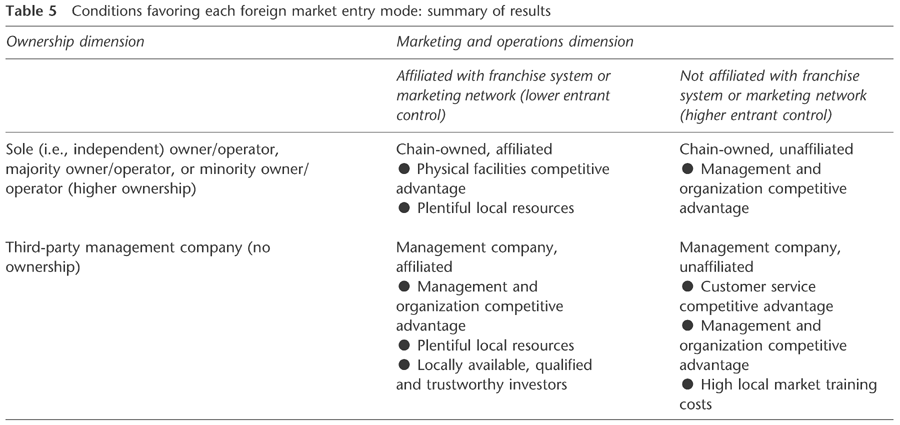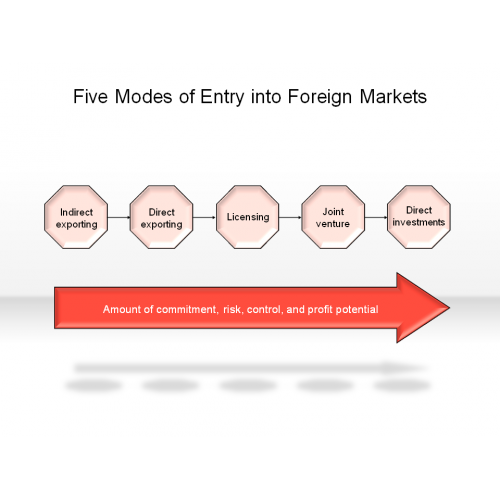Foreign Market Entry Modes
Post on: 4 Апрель, 2015 No Comment

Foreign Market Entry Modes
The decision of how to enter a foreign market can have a significant impact on the results. Expansion into foreign markets can be achieved via the following four mechanisms:
Exporting
Exporting is the marketing and direct sale of domestically-produced goods in another country. Exporting is a traditional and well-established method of reaching foreign markets. Since exporting does not require that the goods be produced in the target country, no investment in foreign production facilities is required. Most of the costs associated with exporting take the form of marketing expenses.
Exporting commonly requires coordination among four players:
- Exporter
- Importer
- Transport provider
- Government
Licensing
Licensing essentially permits a company in the target country to use the property of the licensor. Such property usually is intangible, such as trademarks, patents, and production techniques. The licensee pays a fee in exchange for the rights to use the intangible property and possibly for technical assistance.
Because little investment on the part of the licensor is required, licensing has the potential to provide a very large ROI. However, because the licensee produces and markets the product, potential returns from manufacturing and marketing activities may be lost.
Joint Venture
There are five common objectives in a joint venture: market entry, risk/reward sharing, technology sharing and joint product development, and conforming to government regulations. Other benefits include political connections and distribution channel access that may depend on relationships.
Such alliances often are favorable when:
the partners’ strategic goals converge while their competitive goals diverge;
the partners’ size, market power, and resources are small compared to the industry leaders; and

partners’ are able to learn from one another while limiting access to their own proprietary skills.
The key issues to consider in a joint venture are ownership, control, length of agreement, pricing, technology transfer, local firm capabilities and resources, and government intentions.
Potential problems include:
- conflict over asymmetric new investments
- mistrust over proprietary knowledge
- performance ambiguity — how to split the pie
- lack of parent firm support
- cultural clashes
- if, how, and when to terminate the relationship
Joint ventures have conflicting pressures to cooperate and compete:
Strategic imperative: the partners want to maximize the advantage gained for the joint venture, but they also want to maximize their own competitive position.
The joint venture attempts to develop shared resources, but each firm wants to develop and protect its own proprietary resources.
The joint venture is controlled through negotiations and coordination processes, while each firm would like to have hierarchical control.
Foreign Direct Investment
Foreign direct investment (FDI) is the direct ownership of facilities in the target country. It involves the transfer of resources including capital, technology, and personnel. Direct foreign investment may be made through the acquisition of an existing entity or the establishment of a new enterprise.
Direct ownership provides a high degree of control in the operations and the ability to better know the consumers and competitive environment. However, it requires a high level of resources and a high degree of commitment.
The Case of EuroDisney
Different modes of entry may be more appropriate under different circumstances, and the mode of entry is an important factor in the success of the project. Walt Disney Co. faced the challenge of building a theme park in Europe. Disney’s mode of entry in Japan had been licensing. However, the firm chose direct investment in its European theme park, owning 49% with the remaining 51% held publicly.
Besides the mode of entry, another important element in Disney’s decision was exactly where in Europe to locate. There are many factors in the site selection decision, and a company carefully must define and evaluate the criteria for choosing a location. The problems with the EuroDisney project illustrate that even if a company has been successful in the past, as Disney had been with its California, Florida, and Tokyo theme parks, future success is not guaranteed, especially when moving into a different country and culture. The appropriate adjustments for national differences always should be made.














